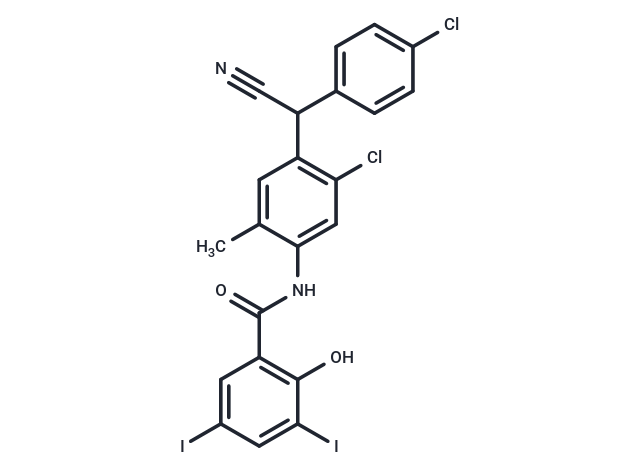Shopping Cart
Remove All Your shopping cart is currently empty
Your shopping cart is currently empty
Closantel (R-31520), a salicylanilide anthelmintic compound, shows different anthelmintic spectra and obvious toxicity in mammals.

| Pack Size | Price | USA Warehouse | Global Warehouse | Quantity |
|---|---|---|---|---|
| 50 mg | $34 | In Stock | In Stock | |
| 100 mg | $54 | In Stock | In Stock | |
| 500 mg | $129 | - | In Stock | |
| 1 g | $192 | - | In Stock | |
| 1 mL x 10 mM (in DMSO) | $37 | In Stock | In Stock |
| Description | Closantel (R-31520), a salicylanilide anthelmintic compound, shows different anthelmintic spectra and obvious toxicity in mammals. |
| In vitro | Closantel (7.5 mg/kg) in combination with a broad-spectrum anthelmintic shows moderate efficacy against caprine Trichostrongylus spp, but is highly effective against Haemonchus contortus. In mice with Fasciola hepatica metacercarial cysts, treatment with closantel (10 mg/kg) leads to extensive peeling on the anterior and posterior extremities, as well as the dorsal and ventral surfaces, resulting in significant overall dermal damage 24 hours post-administration. Furthermore, in sheep infected with resistant H. contortus strains, isotope levels following treatment with radiolabeled closantel are significantly lower compared to susceptible worms. |
| In vivo | Compared to normal conditions, Closantel (50 μg/mL) induces vascular tissue to contract with greater amplitude and higher frequency, reaching a peak muscle tension after approximately 15 minutes, with the amplitude exceeding 1.5 times that of the maximum normal contraction. Additionally, Closantel effectively blocks the infection of host cells by A. phagocytophilum or E. chaffeensis and can clear infections after a one-day treatment in a dose-dependent manner. It also inhibits drug-resistant Enterococcus faecium and Staphylococcus aureus, with minimum inhibitory concentrations (MICs) of 1 μg/mL, and Methicillin-resistant Staphylococcus aureus (MRSA) with a MIC of 2 μg/mL. Moreover, Closantel inhibits the autophosphorylation activity of three sensor kinases derived from E. chaffeensis. |
| Synonyms | R-31520 |
| Molecular Weight | 663.07 |
| Formula | C22H14Cl2I2N2O2 |
| Cas No. | 57808-65-8 |
| Smiles | C(C#N)(C1=C(Cl)C=C(NC(=O)C2=C(O)C(I)=CC(I)=C2)C(C)=C1)C3=CC=C(Cl)C=C3 |
| Relative Density. | 1.8759 g/cm3 (Estimated) |
| Storage | Powder: -20°C for 3 years | In solvent: -80°C for 1 year | Shipping with blue ice/Shipping at ambient temperature. | ||||||||||||||||||||||||||||||
| Solubility Information | Ethanol: < 1 mg/mL (insoluble or slightly soluble) DMSO: 55 mg/mL (82.95 mM), Sonication is recommended. H2O: < 1 mg/mL (insoluble or slightly soluble) | ||||||||||||||||||||||||||||||
| In Vivo Formulation | 10% DMSO+40% PEG300+5% Tween 80+45% Saline: 2 mg/mL (3.02 mM), Sonication is recommended. Please add the solvents sequentially, clarifying the solution as much as possible before adding the next one. Dissolve by heating and/or sonication if necessary. Working solution is recommended to be prepared and used immediately. The formulation provided above is for reference purposes only. In vivo formulations may vary and should be modified based on specific experimental conditions. | ||||||||||||||||||||||||||||||
Solution Preparation Table | |||||||||||||||||||||||||||||||
DMSO
| |||||||||||||||||||||||||||||||
| Size | Quantity | Unit Price | Amount | Operation |
|---|

Copyright © 2015-2025 TargetMol Chemicals Inc. All Rights Reserved.